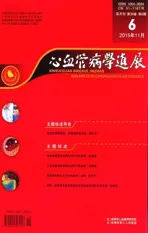成人先天性心脏病心律失常的诊断和治疗进展
2015-02-22郭琳娟综述洪葵审校
郭琳娟 综述 洪葵 审校
(南昌大学第二附属医院心血管内科,江西 南昌330006)
成人先天性心脏病心律失常的诊断和治疗进展
郭琳娟 综述 洪葵 审校
(南昌大学第二附属医院心血管内科,江西 南昌330006)
成人先天性心脏病(CHD)几乎可并发所有类型的心律失常。研究发现,大约有50%的年轻CHD患者最终会发展为快速房性心律失常。成人CHD患者中,心房内折返性心动过速(IART)是最常见的心律失常[1],室性心律失常是猝死的首要因素,其猝死风险是同龄对照组的100倍[2]。成人CHD患者的年龄、缺陷程度和手术修复方式不同,导致各种类型的心律失常的流行程度和发生机制不尽相同。因此,成人CHD心律失常患者的诊断和治疗方案的选择需因人而异[1]。
1 诊断
1.1 心律检查
(1)心电图(ECG):12导联ECG检查是诊断心律失常的基础,主要观察标志性的心房心室异常活动。(2)动态ECG:可用于评估常见的临床症状和心律失常。(3)心肺运动试验:心肺运动试验在提供心律和心肺功能等指标的数据上有优势,也可用于评估患者劳累时的症状。可为窦房结功能、房室传导和非持续性心动过速等提供有效信息,从而了解引起症状的原因。(4)心脏起搏装置和植入式心脏复律除颤器(ICDs):心脏起搏器和ICDs均可记录事件的发生,通过程序设置还可对心房心室进行自动记录或记录符合特定标准的ECG,还能进行长时间自然记录并提供心脏负荷信息[3]。(5)电生理检查:诊断性电生理检查可为已存在的心律失常或手术诱发的心律失常提供特征性结果(位置、机制和其他标志)[4]。电生理检查还可用于筛查成人CHD心律失常患者,评估无症状患者发生猝死或室性心律失常的风险[5]。
1.2 血流动力学检查
(1)超声心动图:经胸超声心动图是成人CHD心律失常患者的首选无创检查方式,能敏感和精确地评估半月瓣和房室瓣功能、左室大小和功能,但在评估右室大小和功能时却不够敏感[1]。若存在人工瓣膜或材料时,可选择经食管超声心动图进行评估。(2)心脏核磁共振成像(MRI):心脏MRI逐渐成为评估成人CHD心律失常的重要工具。将心脏MRI图像导入到心律失常标测系统,可呈现出三维的心内膜结构,并可对房性或室性心动过速进行解剖基础标测和激动标测[6]。(3)心导管检查术/心血管造影术:在控制条件的情况下,心导管检查术可直接对心脏进行压力测定。超过40周岁或伴有其他心脏危险因素的CHD患者,可选择冠状动脉血管造影术来评估室性心律失常[1],这些心脏危险因素包括先天性冠状动脉异常、冠状动静脉瘘、冠状动脉手术史或由导管或支架引起的冠状动脉压迫。
2 治疗
2.1 药物治疗
成人CHD心律失常患者选择药物治疗前,应先排除并发窦房结功能障碍、房室结传导受损、室性功能障碍等疾病。
2.1.1 快速房性心律失常

2.1.1.2 长期管理:治疗中度或复杂形式的成人CHD患者的首要目标是维持窦性心律(窦律),而对于简单形式的成人CHD房颤或IART患者的治疗,控制心率同样重要[7]。心力衰竭(心衰)或非心衰的成人CHD患者的临床随机试验中,比较了控制节律和控制心率之间的差别,发现二者在减少心脏病相关的病死率、心衰相关的住院率、栓塞事件的发生率和患者生活质量上均无统计学差异[8]。

2.1.2 室性心动过速
2.1.2.1 急性终止:胺碘酮、普鲁卡因酰胺和利多卡因静脉制剂广泛应用于成人CHD患者室性心动过速的急性终止,普鲁卡因酰胺能迅速有效地终止单形性室性心动过速的大折返,但使用期间应进行连续血压监测。若室性心动过速是部分去极化引起,利多卡因的治疗效果最佳;若是由触发活动引起,可优先考虑静脉注射腺苷或钙通道拮抗剂进行治疗,但在瘢痕相关性大折返或缺血性室性心动过速存在时,不推荐使用腺苷或钙通道拮抗剂等静脉制剂。
2.1.2.2 长期管理:ICDs是二级预防成人CHD室性心动过速患者发生猝死的首选治疗方案,但ICDs发生误放电的比例为27%~41%,反复放电,尤其是高能量电击,使患者有明显不适和疼痛感,多次放电也会缩短ICDs的使用寿命。索他洛尔可有效地减少ICDs的放电频率,相比于索他洛尔,胺碘酮联合β受体阻滞剂能更有效地预防ICDs电击,但会增加与药物相关的不良心血管事件的发生风险。雷诺嗪可缓解心肌缺血,单独使用或与Ⅲ类抗心律失常药物联用,可有效地减少难治性室性心动过速患者ICDs电击的发生率[14]。
2.2 导管射频消融术
对于成人CHD患者,导管射频消融术前应记录和分析所有可能发生的心律失常,并通过超声心动图、MRI和/或CT扫描获得三维心脏解剖结构。
2.2.1 快速房性心律失常
成人CHD患者外科术后远期易并发快速房性心律失常,最常见的是峡部依赖性(逆时针或顺时针)心房扑动或以瘢痕为基础的大折返,对此类患者,导管射频消融术治疗效果明显优于长期药物治疗[14]。成人CHD快速房性心律失常患者的导管射频消融术成功率为72%~77%,取决于缺陷的复杂程度[15]。若患者存在异常心房解剖,推荐应用三维电解剖标测来指导射频消融治疗。靶点消融术可通过激动顺序标测、电压标测与拖带标测来选择治疗靶点。冷盐水灌注大头导管消融可提高成人CHD外科术后并发快速房性心律失常患者的射频消融成功率[16]。
2.2.2 房颤
成人CHD房颤患者的导管射频消融术包括环肺静脉隔离、左房碎裂电位消融和峡部切除等。手术的复杂性在于合理利用相关技术来实时监测和/或记录心脏容积成像[17],使相关的解剖可视化。
2.2.3 室性心动过速
由于持续性单形性室性心动过速与猝死的关系不是很明确,且在急性消融术后有相对较高的复发率,因此,射频消融术很少应用于室性心动过速患者,或仅在特殊情况下作为ICDs治疗的一种辅助替代方案[18]。但心脏解剖结构正常的成人CHD患者频发单形性室性心律失常是射频消融的适应证。成人CHD室性心动过速患者的射频消融方式与房性心动过速消融方式相似,均可利用心内起搏标测和电激动标测来定位消融靶点。成人CHD室性心动过速患者行射频消融术的主要挑战在于消融时必须阻断心室肌解剖上的折返回路。
2.3 心脏起搏器
2.3.1 窦房结功能不全
成人CHD并发窦房结功能障碍患者最好选择ECG、动态ECG、事件记录器和运动负荷试验来进行评估[19]。若成人CHD窦房结功能不全患者出现心动过缓或房室同步异常等相关临床症状,建议心脏起搏治疗,荟萃分析发现AAI或DDD起搏优于单独的VVI起搏,但运动耐力极差的心功能不全患者不是永久性起搏器的临床适应证[20]。成人CHD窦房结功能障碍并发IART或有高度倾向发展为IART的患者应考虑抗心动过速起搏治疗,而慢-快综合征则需要药物、导管消融和/或起搏等多途径联合治疗[19]。
2.3.2 房室传导功能障碍
对于成人CHD房室传导阻滞患者,DDD起搏优于VVI起搏。成人CHD非永久性IART或有发展为IART的解剖基础的患者,即使存在完全性房室传导阻滞,仍可选择心房起搏来控制房性心动过速[21]。
2.4 ICDs
ICDs是病因不明的各种类型的成人CHD患者心脏性猝死复苏后或自发性持续性室性心动过速患者的主要治疗方式,也可作为持续性室性心动过速血流动力学紊乱引起的不明原因晕厥的成人CHD患者,尤其是有基础疾病的高风险患者的一级预防[22]。法洛四联症患者若合并左心室功能不全、非持续性室性心动过速、QRS>180 ms、右心室瘢痕或可诱发持续性室性心动过速等猝死危险因素时,植入ICD是合理的[23]。
2.5 手术治疗
成人CHD阵发性或持续性房颤或IART患者中,最常见手术方式是迷宫手术,手术可同时治疗房颤和结构性心脏缺陷。由于成人CHD房颤患者常发生在左侧心脏结构异常、心功能不全或未进行手术修复的间隔缺损等基础疾病的患者中[24],因此可选择双心房Cox迷宫Ⅲ型手术,统计发现,手术成功治疗了超过70%的成人CHD房颤患者,手术的同时还可进行二尖瓣修复、房间隔缺损闭合或冠状动脉旁路移植术[25]。房室折返性心动过速经导管消融失败后或同时需要手术治疗器质性心脏疾病时可考虑选择手术治疗。
3 总结
结构性心律失常的治疗具有挑战性。在原有药物治疗效果有限的基础上,随着介入技术的发展,射频消融术和器械治疗拯救和延长了不少CHD心律失常患者的生命。因此,在治疗成人CHD患者时,了解结构性心脏病发生心律失常的机制、各种治疗方法的原理和关键技术,结合临床检查结果仔细分析病情,选择合适的治疗方式以达到最有效的治疗效果非常重要[26]。
[1] Mondesert B, Dubin AM, Khairy P. Diagnostic tools for arrhythmia detection in adults with congenital heart disease and heart failure[J]. Heart Fail Clin,2014,10(1):57-67.
[2] Go AS, Mozaffarian D, Roger VL, et al. Heart disease and stroke statistics—2013 update: a report from the American Heart Association[J]. Circulation,2013,127(1):e6-e245.
[3] Czosek RJ, Anderson J, Khoury PR, et al. Utility of ambulatory monitoring in patients with congenital heart disease[J]. Am J Cardiol,2013,111(5):723-730.
[4] Walsh EP, Bar-Cohen Y, Batra AS, et al. Recommendations for advanced fellowship training in clinical pediatric and congenital electrophysiology: a report from the training and credentialing committee of the pediatric and congenital electrophysiology society[J]. Heart Rhythm,2013,10(5):775-781.
[5] Sherwin ED, Triedman JK, Walsh EP. Update on interventional electrophysiology in congenital heart disease: evolving solutions for complex hearts[J]. Circ Arrhythm Electrophysiol,2013,6(5):1032-1040.
[6] Suman-Horduna I, Roy D, Frasure-Smith N, et al. Quality of life and functional capacity in patients with atrial fibrillation and congestive heart failure[J]. J Am Coll Cardiol,2013,61(4):455-460.
[7] Stan MN, Hess EP, Bahn RS, et al. A risk prediction index for amiodarone-induced thyrotoxicosis in adults with congenital heart disease[J]. J Thyroid Res,2012,2012:210529.
[8] Koyak Z, Kroon B, de Groot JR, et al. Efficacy of antiarrhythmic drugs in adults with congenital heart disease and supraventricular tachycardias[J]. Am J Cardiol,2013,112(9):1461-1467.
[9] Skanes AC, Healey JS, Cairns JA, et al. Focused 2012 update of the Canadian Cardiovascular Society atrial fibrillation guidelines: recommendations for stroke prevention and rate/rhythm control[J]. Can J Cardiol,2012,28(2):125-136.
[10]Anderson JL, Halperin JL, Albert NM, et al. Management of patients with atrial fibrillation (compilation of 2006 ACCF/AHA/ESC and 2011 ACCF/AHA/HRS recommendations): a report of the American College of Cardiology/American Heart Association Task Force on Practice Guidelines[J]. J Am Coll Cardiol,2013,61(18):1935-1944.
[11]Gao D, Van Herendael H, Alshengeiti L, et al. Mexiletine as an adjunctive therapy to amiodarone reduces the frequency of ventricular tachyarrhythmia events in patients with an implantable defibrillator[J]. J Cardiovasc Pharmacol,2013,62(2):199-204.
[12]Windram JD, Siu SC, Wald RM, et al. New directives in cardiac imaging: imaging the adult with congenital heart disease[J]. Can J Cardiol,2013,29(7):830-840.
[13]Banchs JE, Baquero GA, Nickolaus MJ, et al. Clinical efficacy of dofetilide for the treatment of atrial tachyarrhythmias in adults with congenital heart disease[J]. Congenit Heart Dis,2014,9(3):221-227.
[14]Russo AM, Stainback RF, Bailey SR, et al. ACCF/HRS/AHA/ASE/HFSA/SCAI/SCCT/SCMR 2013 appropriate use criteria for implantable cardioverter-defibrillators and cardiac resynchronization therapy: a report of the American College of Cardiology Foundation appropriate use criteria task force, Heart Rhythm Society, American Heart Association, American Society of Echocardiography, Heart Failure Society of America, Society for Cardiovascular Angiography and Interventions, Society of Cardiovascular Computed Tomography, and Society for Cardiovascular Magnetic Resonance[J]. J Am Coll Cardiol,2013,61(12):1318-1368.
[15]Balaji S, Daga A, Bradley DJ, et al. An international multicenter study comparing arrhythmia prevalence between the intracardiac lateral tunnel and the extracardiac conduit type of Fontan operations[J]. J Thorac Cardiovasc Surg,2014,148(2):576-581.
[16]Patel S, Shah D, Chintala K, et al. Atrial baffle problems following the Mustard operation in children and young adults with dextro-transposition of the great arteries: the need for improved clinical detection in the current era[J]. Congenit Heart Dis,2011,6(5):466-474.
[17]Rosenberg MA, Samuel M, Thosani A, et al. Use of a noninvasive continuous monitoring device in the management of atrial fibrillation: a pilot study[J]. Pacing Clin Electrophysiol,2013,36(3):328-333.
[18]Prystowsky EN, Padanilam BJ, Joshi S, et al. Ventricular arrhythmias in the absence of structural heart disease[J]. J Am Coll Cardiol,2012,59(20):1733-1744.
[19]Perry JC. Sudden cardiac death and malignant arrhythmias: the scope of the problem in adult congenital heart patients[J]. Pediatr Cardiol,2012,33(3):484-490.
[20]Janousek J, van Geldorp IE, Krupickova S, et al. Permanent cardiac pacing in children: choosing the optimal pacing site: a multicenter study[J]. Circulation,2013,127(5):613-623.
[21]Brignole M, Auricchio A, Baron-Esquivias G, et al. 2013 ESC Guidelines on cardiac pacing and cardiac resynchronization therapy: the Task Force on cardiac pacing and resynchronization therapy of the European Society of Cardiology (ESC). Developed in collaboration with the European Heart Rhythm Association (EHRA)[J]. Eur Heart J,2013,34(29):2281-2329.
[22]Mondesert B, Khairy P. Implantable cardioverter-defibrillators in congenital heart disease[J]. Curr Opin Cardiol,2014,29(1):45-52.
[23]Thibault B, Ducharme A, Harel F, et al. Left ventricular versus simultaneous biventricular pacing in patients with heart failure and a QRS complex >/=120 milliseconds[J]. Circulation,2011,124(25):2874-2881.
[24]Robertson JO, Lawrance CP, Maniar HS, et al. Surgical techniques used for the treatment of atrial fibrillation[J]. Circ J,2013,77(8):1941-1951.
[25]Junge C, Westhoff-Bleck M, Schoof S, et al. Comparison of late results of arterial switch versus atrial switch (mustard procedure) operation for transposition of the great arteries[J]. Am J Cardiol,2013,111(10):1505-1509.
[26]Mondesert B, Abadir S, Khairy P. Arrhythmias in adult congenital heart disease: the year in review[J]. Curr Opin Cardiol,2013,28(3):354-359.
Advances in Diagnosis and Treatment of Adult Congenital Heart Disease with Arrhythmia
GUO Linjuan, HONG Kui
(CardiologyDepartment,TheSecondAffiliatedHospitalofNanchangUniversity,Nanchang330006,Jiangxi,China)
先天性心脏病(CHD)治疗技术的快速进展使得在发达国家有超过90%的CHD儿童能存活到成年,导致成人CHD患者数量远远超过儿童CHD患者数量。心律失常患者可表现为从无症状到有致命性症状,其复杂性和治疗方面的挑战性,要求临床医生必须对患者进行实时监测、严格评估、综合考虑,最后选择最佳的治疗方案。现根据最新颁布的相关专家共识,就成人CHD心律失常患者的诊断和治疗进展进行阐述。
先天性心脏病;心律失常;诊断;治疗
In developed countries,the rapid, aggressive and progressive treatment of congenital heart disease (CHD) enables more than 90% of CHD children to successfully grow into adults. As a result,the number of adult patients with CHD far outnumber that of pediatric CHD patients. Arrhythmia patients may have different manifestations from asymptomatic to fatal symptoms. Due to the complex and challenging of the treatment of arrhythmia, clinicians must monitor, evaluate and comprehensively understand their patients’ needs to help them choose the optimal treatment program. This article reviews primarily about the diagnosis progress and treatment of adult CHD patients with arrhythmia.
congenital heart disease; arrhythmia; diagnose; therapy
1004-3934(2015)06-0752-04
R541.1
A
10.3969/j.issn.1004-3934.2015.06.024
2015-06-01
2015-07-21
